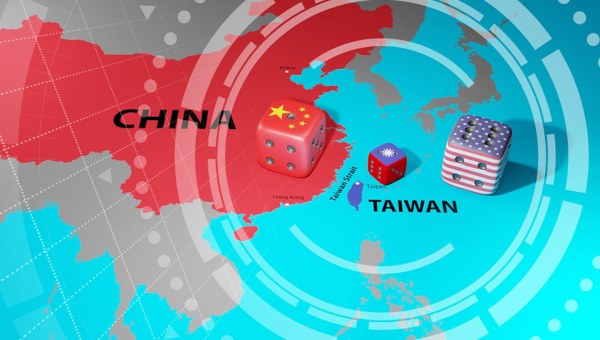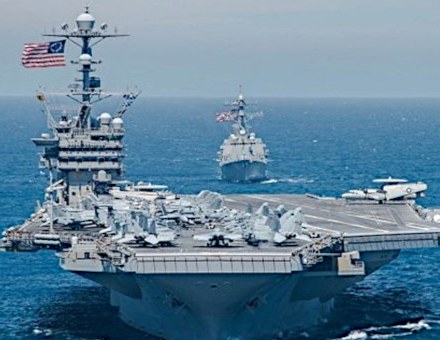How US Converted Taiwan Into a Launchpad for War with China
When the US House Speaker Nancy Pelosi visited Taiwan on 2 August 2022, it predictably enraged China because the island is part of China. The visit was thus a condescending challenge to China especially when it was backed up by a US aircraft carrier battle group and military jets.
Pentagon provided fighter jets as escorts for Pelosi’s congressional visit with an increased US naval presence. Two aircraft carriers, two amphibious assault ships, 36 warships and three submarines were in the vicinity of Taiwan. US chairman of the Joint Chiefs of Staff, General Mark Milley, declared that America’s armed forces were ready to “do what is necessary to ensure a safe conduct of the visit.”
Taiwan is 161 Km from mainland China, and so it is barely surprising that China responded to the US move with counter moves. With the visit the war of words between China and the US spiked upward, opening a new rift in US-China relations, leading to an intensified military confrontation.

Erosion of US-China Relations
Some apprehension was expressed in the Biden administration about the visit to which he responded waveringly: “I think that the military believe it’s not a good idea right now, but I don’t know what the status of it is.” At the same time, the White House claimed it has no jurisdiction over Pelosi’s decision to go to Taiwan, although she was going in a military plane. It is hardly imaginable that Pelosi would plan a congressional trip to Taiwan without an approval from the White House and Pentagon.
Her visit signified further erosion of the US’s erstwhile “one China” policy and a shift toward a “One China, One Taiwan” policy, along with an unequivocal commitment to intervene militarily on Taiwan’s behalf. In fact the Biden administration is more hawkish on China than its predecessor, helping to fuel this shift in policy. In March 2021 Biden declared: “We will support Taiwan … in line with longstanding American commitments.” Since then he pledged multiple times US military intrusion in Taiwan, thus fanning the burning tensions between Beijing and Washington.
On July 28, Chinese President Xi Jinping spoke with President Joe Biden on the phone at the request of the latter. As they were talking the Pentagon was organizing a security conference in Sydney, Australia, attended by top military commanders from 26 countries in the Asia-Pacific region. At the same time the CHIPS (Creating Helpful Incentives to Produce Semiconductors) and Science Act was passed in the US Senate. These are key moves by the US to contain China militarily and economically.
The New York Times ran a headline: “Biden’s Taiwan Policy Is Truly, Deeply Reckless.” Writer Peter Beinart pointed out that right from the onset of his presidency Biden was “chipping away” at the longstanding US “one China policy.” He said Biden became the first American president since 1978 to invite Taiwan’s envoy at his inauguration.
Beinart furthermore cautioned that the more the US closes the door on peaceful reunification, the more likely Beijing is to seek reunification by force.
Financial Times reported how national security adviser Jake Sullivan and other senior National Security Council officials opposed Pelosi’s trip due to the “risk of escalating tension across the Taiwan Strait.”
The Pelosi trip was aimed at openly challenging the One China agreement while stopping China from becoming the global economic power. The US empire is not going to have a future where China dominates. No hegemony has ever allowed that. Taiwan is thus a means of targeting China, isolating and portraying it as aggressive and threat to peace.
And so, for the first time, Japan, Australia, New Zealand and South Korea were invited to a NATO Summit as “Indo-Pacific partners.” It is part of NATO’s new strategic plan that explicitly mentions China “challenge[s] our interests, security and values.”
Actually by targeting China as a “threat,” the Biden administration is reacting to mounting economic and political crisis at home. For Democratic party being hard on China is a vote-catcher while being puny on China is a vote-loser. Pelosi’s visit thus came at an opportune moment for the Democratic Party as an attempt to retain its current majority in the coming mid-term in November.
And so, prior to Pelosi’s arrival, US muscle flexing moved into high gear when the nuclear-powered and armed aircraft carrier USS Ronald Reagan, with full complement of warplanes, warships, a guided missile destroyer cruiser, destroyers and nuclear submarines, were deployed in the South China Sea, near the Taiwan Strait. They conducted maritime strike exercises, supposedly on a “routine patrol.”
US Warships and Military Games
On August 28 two US Navy warships entered the Taiwan Strait. They were the guided-missile cruisers USS Antietam and USS Chancellorsville of the Seventh Fleet based in Japan. These are Ticonderoga-class guided-missile destroyers that each have 80 SM-2 surface-to-air missiles, 16 ASROC anti-submarine rockets and 26 Tomahawk cruise missiles with 330 service people on board. Other US Navy guided missile destroyers, USS Benfold and USS Port Royal sailed through the straight.
On the other side, Chinese warships and aircraft repeatedly kept within the median line of the Taiwan Strait. Chinese government announced that it was staging large live-fire drills with military aircraft in the Taiwan Strait as well as over the island itself, while deploying naval ships into the areas. China also broadcast footage of its destroyer firing weapons in the South China Sea, through which the USS Ronald Reagan aircraft carrier group was reportedly sailing.

Furthermore, China cancelled the China-US Theatre Commanders meetings, China-US Defense Policy Coordination talks and China-US Military Maritime Consultative Agreement meetings. Multiple telephone calls by US Defense Secretary Lloyd Austin and Joint Chiefs Chair General Mark Milley were reportedly not returned by their Chinese counterparts. This collapse of direct US-China military contact intensifies the risk of an accident triggering off a broader conflict in the midst of the tense confrontation between their forces.
US has been progressively arming Taiwan, increasing the hazard of military escalation. This year Boeing got the contract to produce Harpoon Coastal Defense Systems for Taiwan. This came when a US delegation visited Taiwan to discuss military cooperation. Meanwhile, the Biden administration has announced a $1.1-billion arms sale to Taiwan including Harpoon air-to-sea missiles and Sidewinder air-to-air missiles, surveillance radar programme.
In 2011 President Obama declared a “Pivot to Asia,” aiming at encircling and containing China. Then came Trump who planned for major power conflict with China, taking military confrontation with a trade war. Biden took it even further, with Democrats and Republicans legislators trying to outmaneuver each other in anti-China hostility. At the end of 2021 the US military presence in Taiwan doubled, with US training Taiwan soldiers, while increasing US weapon sales such as drones, Stinger anti-aircraft missiles and Javelin anti-tank missiles, the M142 High Mobility Artillery Rocket System and naval sea mines.
In 1972 an agreement was signed between Chinese Premier Zhou Enlai and US President Richard Nixon. It was the Joint Communiqué drafted by a team led by Henry Kissinger. US thus gave a written undertaking of noninterference in its internal affairs, as well as respect for its sovereignty and territorial integrity.
In 1978 the Carter administration established diplomatic relations with the People’s Republic of China. The US then stuck (in public at least) to the One China concept, under which US conceded that Taiwan and the mainland are both parts of “one China.” Not only US recognized Taiwan as an integral part of China but it also severed diplomatic and military ties with Taiwan while removing its embassy and its troops from the island.
But then Carter signed the Taiwan Relations Act of 1979 under which US pledged to provide Taiwan with defensive arms “as needed.”
Washington has thus dishonored the “one China policy” multiple times. But then it is hardly surprising, as it did the same, for example, with the JCPOA nuclear deal with Iran and the “not one inch eastward” pledge given to Gorbachev on NATO expansion in Europe. •





